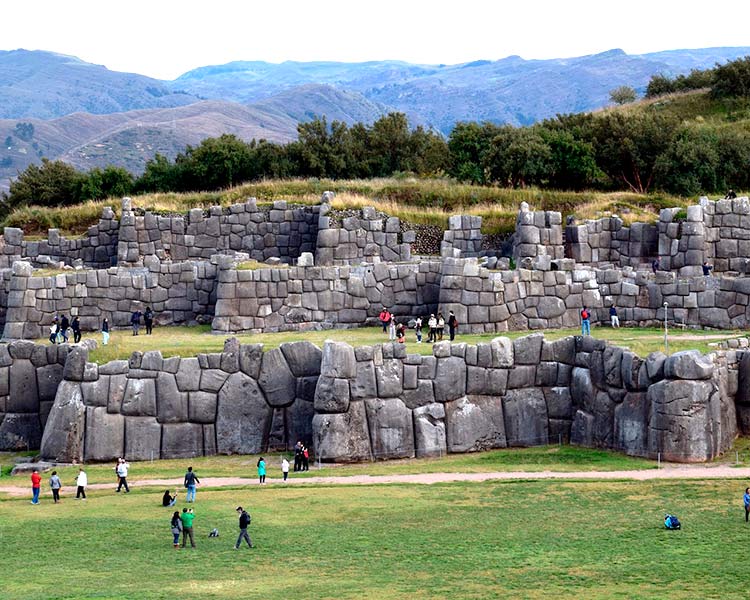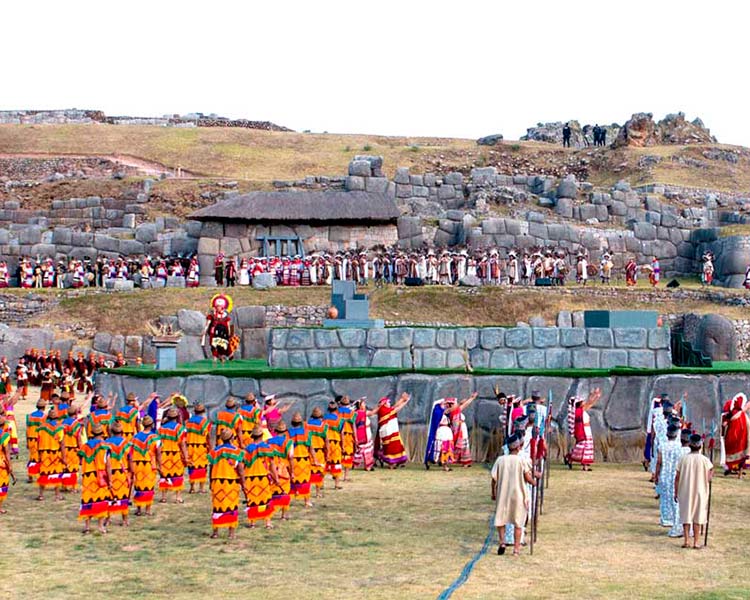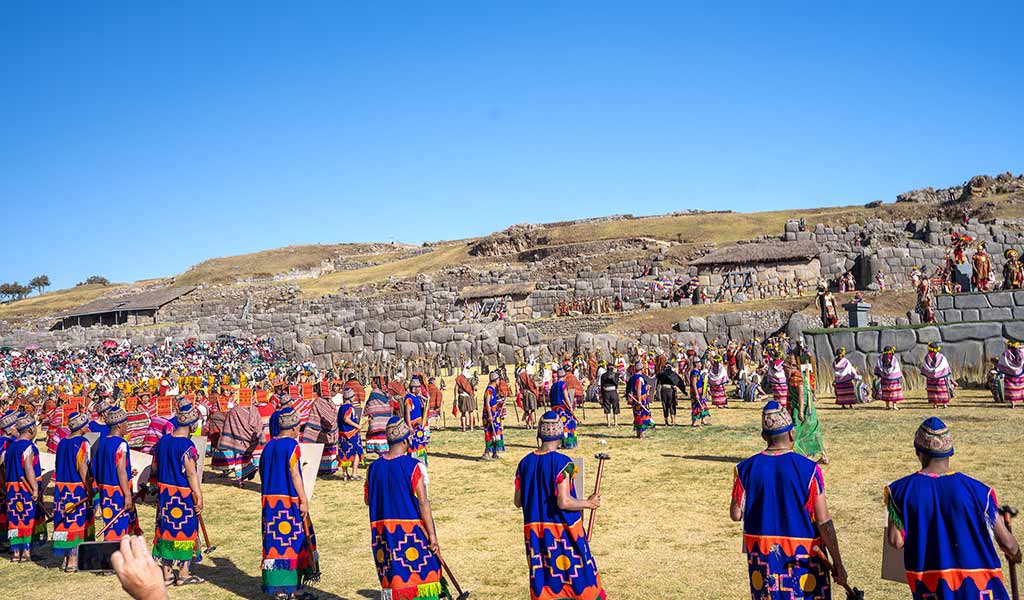The Inti Raymi in Sacsayhuamán in Cusco
The Sacsayhuamán fortress is the scene of the main Inti Raymi show. This festival, which has its origins in the same Inca era, takes place every year on June 24. That day is a holiday (non-working day) in Cusco. There are three shows of the great event: the Coricancha, in Main Square and, mainly, in Sacsayhuamán. This great event has global resonance. Learn how it is celebrated, the history and more about Inti Raymi in this historic setting.
Content:
The archaeological site of Sacsayhuamán

Sacsayhuamán is the most visited archaeological site in Cusco (according to official data in 2023). It is famous for its immense stone walls made of rocks weighing up to 120 tons. Also for its great history, even before the Incas and where one of the most decisive battles between the Spanish and the Incas took place in the 16th century.
It is located to the north, just two kilometers by road from the city of Cusco. It covers a huge area of 3,093 hectares. Its name, translated from the Quechua language, means ‘Satisfied Falcon’, perhaps due to the presence of this bird at certain times of the year. Its function was as a ceremonial center, where the Incas showed their great knowledge of architecture.
Sacsayhuamán would have already existed before the arrival of the Incas to the Cusco valley, approximately in the 12th century. During the rule of the great emperor Pachacutec (1418 – 1471 AD), its structures were rebuilt with immense stone walls. The perfection of its walls is such that there is a debate about how the Incas managed to move and carve such heavy and immense walls to perfection.
Some chroniclers, such as Bernabé Cobo and Guamán de Poma de Ayala, suggest that embankments, ramps and the patient effort of thousands of men were used for the placement and carving of its stones ( The Incas did not have the wheel system as we know it today). The truth is that upon the arrival of the Spanish in the 16th century, they believed that the construction of Sacsayhuamán was the product of the devil (today it is even popularly reported that it was the work of extraterrestrials).
The walls of Sacsayhuamán are so resistant and perfect that the Spanish did not manage to destroy it during the invasion of Cusco in the 16th century. There a fierce battle took place between the Incas and the Spanish (on May 16, 1536). The result was the flight of the Incas (led by Manco Inca) into the jungle and the destruction of a large part of the current archaeological site.
After the Spanish victory, many walls of Sacsayhuamán were destroyed for the construction of colonial temples such as the Cathedral of Cusco. It is estimated that today the archaeological site only shows twenty percent of its original form. Still, this one is amazing for visitors.
In the 20th century it was decided to use the esplanade of the archaeological site of Sacsayhuamán for the representation of the Inti Raymi festival (the 24th of June). The Incas celebrated this great festival in honor of the sun in other settings of great importance such as the Main Square (Huacaypata in Inca times) and the Coricancha temple (the golden temple in honor of the sun).
How to visit Sacsayhuamán after or before Inti Raymi?
Sacsayhuamán in the Inca era
The Incas designed Sacsayhuamán following the figure of a puma, considered a sacred animal. The head of this feline was in this Inca temple, while the tail was in the Coricancha, the temple of the sun.
It was Emperor Pachacutec who ordered the remodeling and erection of large stone walls in Sacsayhuamán. There were three rows of zigzag-shaped walls whose maximum height reaches 9 meters. It is estimated that the heaviest stone – which fits perfectly with the rest of the wall – weighs 120 tons.
Its construction required the work of nearly twenty thousand men. Part of the work was drilling the stone blocks, transporting them on strong ropes and the final tenacious carving with the rest of the wall. It is estimated that its construction took up to 50 years.
It is known that Sacsayhuamán was a religious site of great importance. However, it is also presumed that it served as a military fortress. During the Spanish invasion it served as a point of military resistance for the Incas against the Spanish invaders.
In addition to stone walls and shrines, canals and water sources were built in Sacsayhuamán, as well as colcas or food warehouses. Its most important areas are the amphitheaters, the chincanas (tunnels), the bases of the towers, the ruts, the Inca throne and more.
The most famous towers were in the highest part of the site: the Paucamarca, the Sallacmarca and the Muyucmarca. They rose up to 22 meters with panoramic views of the city of Cusco. During the Spanish invasion (16th century) they were destroyed and today only their bases can be seen. According to the Inca chronicler Garcilaso de la Vega, during the battle of Sacsayhuamán (1536) the Inca soldier Cahuida threw himself from the Muyucmarca tower to avoid falling prisoner to the Spanish. Today this building is also known as ‘Cahuide tower’.
Today Sacsayhuamán is also famous for being the most important setting for Inti Raymi, the festival of the sun god (Inti). This celebration takes place every year on June 24.
The Inti Raymi in Sacsayhuamán

The Inti Raymi has its main stage in the Sacsayhuamán fortress. That day, June 24, a stage is erected on the esplanade of the archaeological site. In addition, there is the participation of up to 500 Cusco actors and actresses, some placing themselves on the large stone walls of the Inca temple.
The Inti Raymi in Sacsayhuamán starts at 2 in the afternoon and lasts approximately 2 hours 30 minutes. Three large stands are placed around the main stage: orange seats, red seats and green seats. There, by purchasing a ticket, those attending this important event are placed.
The show begins with the appearance of the sinchi, or guard of the Inca emperor. He inspects the place, announcing that the sun festival can now begin. Then, emissaries from the four corners of the empire make their appearance with a great show of dance and live music. From the walls of Sacsayhuamán you can see the virgins of the sun dancing and announcing the arrival of the Inca.
The Inca and his wife (coya) enter with great joy from the emissaries of the four of his or regions of the empire . Each legion wears clothing characteristic of its place of origin and pays tribute to the sun with typical dances of its region.
The Inca and the high priest lead the ceremony of homage to the sun. They perform the sacrifice of a black llama (considered sacred to the Incas). This burns in the main fire and the high priest announces whether it will be an auspicious and favorable year for the Incas. Each representative from each corner of the Tahuantinsuyo (empire of the four of them) makes their offering to the great Inca through gifts and dances.
The Inti Raymi show is performed in the Quechua language, the language of the Incas. At the end all the actors and actresses parade around the Sacsayhuamán esplanade taking photographs with the attendees. The Inca says goodbye under a radiant sun, until the next Inti Raymi.
The Inti Raymi in Sacsayhuamán and the other scenarios: differences
In addition to Sacsayhuamán, the Inti Raymi is held in the Main Square and the Coricancha. Know the differences!
| Inti Raymi | Sacsayhuamán | Main Square | Coricancha |
|---|---|---|---|
| Location | 2 kilometers from the center of Cusco | In the heart of the city | 500 meters walk from the Main Square |
| Altitude | 3,700 meters above sea level | 3,399 meters above sea level | 3,399 meters above sea level |
| Start time | 2 in the afternoon | 11 in the morning | 9 in the morning |
| Duration | 2 hours 30 minutes | 45 minutes | 45 minutes |
| Actors | Around 500 actors | About 300 actors | About 300 actors |
| Drama | The Inca performs the fire ceremony and asks for the blessing of the sun (sacrifices and offerings) | The Inca reads the coca leaf | The Inca performs the starting ceremony of Inti Raymi |
| Input | Sale of seats online | Free attendance (there are no seats) | Free assistance (optional seats) |
Inti Raymi in Sacsayhuamán: prices
These are the approximate prices for the Inti Raymi show on the Sacsayhuamán esplanade:
| Inti Raymi | orange tribune | red tribune | Green tribune |
|---|---|---|---|
| General | 164 USD | 165 USD | 106 USD |
| Foreign children | 80 USD | 80 USD | 53 USD |
| Tourist guides | 80 USD | 80 USD | 53 USD |
Tips for your visit
Tickets to the Inti Raymi in Sacsayhuamán have limited availability and sell out quickly. It is recommended to make the purchase (online) two or three months in advance.
The Inti Raymi in Sacsayhuamán has a hot climate so it is recommended to bring sunscreen, a hat, rehydrating water and snacks.
Sacsayhuamán is an Inca archaeological site of great historical value. During and after the Inti Raymi show, throw trash in the corresponding bins. Do not contaminate a place of great historical value for Peru and the world.
